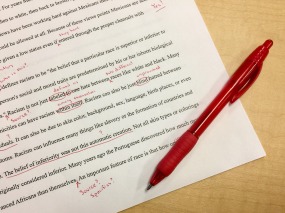I’ve used the same editor for all of my books. Her guidance has been invaluable, and my growth as a writer is due largely to the critiques that she sends back on my drafts. What has been consistent throughout this process is my inclusion of a word that I thought I had a handle on, but clearly did not, since this last round of edits I was reminded that I should be looking for ways to avoid it. The word I have trouble with, among others, is “that.”
I have become an avid Twitter follower, and I see a ton of posts by other writers who voice their frustration when it comes to words they use too frequently. While it is nice to know I am not alone in this, it would have been nice to know early on that I could have saved myself a lot of headache with Microsoft Word’s “find” feature. For anyone just starting out, you can find it under the Editing portion of your toolbar. Putting a word in the “find” space and hitting enter will take you to each instance of that word within your manuscript. You can then judge if the crutch word is “necessary.” In my case, they were only needed about 10% of the time. This is also a handy tool if you change a character’s name halfway through a manuscript, or change the tense in your story…learned that a bit too late as well. 🙂

In the draft of my first book, I removed well over 1,200 “thats” and still had more to take out after the second draft was edited. For book two, I had a lot less to remove, but still had enough of them that my poor editor had to mention the “find” function of Word again. While drafting book three, I kept the word “that” in my mind as I wrote, paying special attention to the sentences that included it, and eliminated the word as I went. I still had several to remove – there seems to be no getting around “that!”
What I realize from following other writers on Twitter, is that (there it is again) there are certain words we include without too much thought, and for each writer, these “crutch” words can be different. Here are a few I have found along the way that you should be on the lookout for:
- That – If you can remove the word “that” from a sentence and it still makes sense, it can be eliminated.
- Really, Actually, Very – If it ends in a “y” you may be able to live without it.
- Feel, Wonder, Understand – Anything word that “tells” us what is going on instead of “showing” us, should be changed, although I would take this one step further. Using a word that makes the reader “feel” what is going on is always the way to go.
- Running, Staring, Eating – If it ends in “ing” you can find a stronger and less passive way to say it.
If you are a writer and haven’t tapped into Twitter yet, I would highly recommend checking it out. The support you receive when you connect with other like-minded folks is amazing! I have found some great people through the following #s:
#AmWriting, #TurtleWriters, #DolphinWriters, #WritingTribe, #WritingCommunity
If you are new to the community, give me a follow and let me know you are there! Would love to make a connection!
No matter what you write and how you go about it, eliminating the words that you plant out of habit is always a good place to start when self-editing. You’ll be surprised how a few little words can make a huge impact on your writing, whether adding them or eliminating them from your work-in-progress.
What are some of the words that give you trouble? Leave me a note below, would love to know! In the meantime,
Happy Writing! XO
Some wonderful advice from posts I found along the way:
https://dianaurban.com/words-you-should-cut-from-your-writing-immediately
https://thewritepractice.com/better-writer-now/


Was is my bette noir, closely followed by that… drives me insane…
LikeLiked by 1 person
You would think by now I would have broken the habit! I am going to start looking for “was,” now that you mentioned it, I feel compelled to double-check myself! lol
LikeLiked by 1 person
When that ‘find’ button tells you just how many there are, my heart sinks…
LikeLiked by 1 person
Reblogged this on anita dawes and jaye marie.
LikeLiked by 1 person
Reblogged this on The Reluctant Poet.
LikeLike